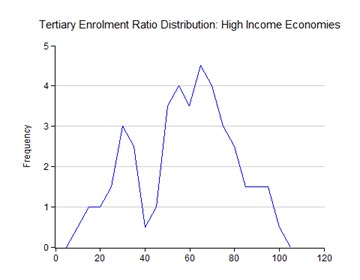Speaking about the level of tertiary enrolment in Malaysia, the Deputy Director-General of the Ministry of Higher Education says the World Bank numbers are incorrect:
Higher education more accessible
KUALA LUMPUR: Accessibility to higher education in Malaysia is around the 40% mark, and not 29% as reported by the World Bank.
Higher Education Ministry deputy director-general (private higher education institutions) Prof Datin Dr Siti Hamisah Tapsir said the World Bank did not factor in those pursuing A-levels or equivalent qualifications resulting in the unfavourable score.
“We need to correct this as the issue was recently raised in Parliament,” she said in her speech after opening The Star Education Fair 2011 on behalf of Higher Education Minister Datuk Seri Mohamed Khaled Nordin, who is overseas.
“In fact, around 40% of youth – those aged between 17 and 21 – are enrolled at higher education institutions,” she added.
You can check the data for yourself via the World Bank’s database. The actual figure quoted for Malaysia (as of 2007) is 32%.
What’s perplexing about the MoHE’s viewpoint is that the World Bank collates data from official sources – if you’re not tracking it, they don’t report it. So in essence, what the Prof Hamisah is complaining about is the accuracy of our own data…or lack thereof.
Another problem is that whether we’re going by the “official” 32% or MoHE’s 40%, it’s still not enough. Looking at all the countries classified as “high-income” by the World Bank (using 2007 data, which is currently more complete than 2008 with about 75% reporting the relevant info), the average enrolment ratio is 57.4% (Median: 60.1%):
The range is fairly wide (from Qatar at 11.2% to Korea at an amazing 96.1%), though those at the lower end are almost universally very small economies, in the Middle East, or in the Caribbean. Weighting by population, we’re almost certain to see a much higher average enrolment ratio associated with high income economies – the bulk of the observations are in the 50% to 70% range:
So using 32% or 40% is nit-picking – by any standard, we’ve still got a job to do in expanding tertiary capacity and enrolment, especially with the big school cohorts coming of age over the next twenty years.
And not mentioned at all in this context is the gender imbalance – the 2010 Census shows a population that’s weighted towards males by 105:100. Yet enrolment is tilted the other way, with the 33% of girls entering tertiary education as against just 27% of boys. What that will do in terms of societal pressures and evolution, I won’t even hazard to guess at.





Hi Hisham, I think tertiary education is not an end all, especially in the context of the following questions:
ReplyDelete1. What about quality?
2. What about mismatch (e.g. tertiary education programmes not matching structure of the economy or job demands)
3. What about job creation (are there enough jobs to absorb the graduates)
4. Wages - does the premium in wages for graduates match the investment in tertiary education.
I'd prefer organic growth rather than targeting some percentage.
Cheers
Greg
Hi Greg,
ReplyDeletePertinent questions all.
1. I think the quality issue isn't one that's really solvable at the tertiary level - the solution has to start earlier. As they say, garbage in, garbage out.
2. There're are a few moves being made to reduce the severity of this problem, mainly through greater involvement between universities and industry. My sense is that this issue is more strongly a problem with public research universities where the emphasis is more on theory rather than practice. The problem is also (in my view) related to quotas and capacity constraints - many students are funneled to areas where they have no interest, simply because there aren't enough places in popular courses. Incentives in academia are also badly skewed against practical learning, which is why I'm strongly in favour of expanding vocational education at both secondary and tertiary levels.
3. Isn't that what organic growth is for? This issue is actually related to point 2 - the demand is there, the skills mostly are not.
4. Wish there was some research (on the Malaysian market) for us to reference here. But the lit in developed countries suggests the premium is pretty high.
On your last point, I agree. What bothers me about the article is less about targets, but rather the denial that there is a problem in the first place. Whether we target 50% or 80% is to me irrelevant (and probably counterproductive), as long as there is a recognition that capacity has to increase in the future - and there are almost no signs that the ministry sees this at all.